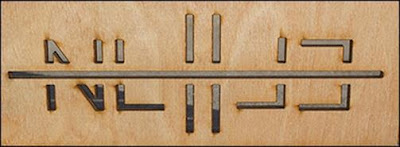Tag: exhibit
OHC Exhibit “Voices for the Environment” Curator Q&A
The Oral History Center is excited to announce the opening of Voices for the Environment: A Century of Bay Area Activism, a Bancroft Library Gallery exhibition that was curated by Todd Holmes, Roger Eardley-Pryor, and Paul Burnett. Voices for the Environment traces the evolution of environmentalism in the San Francisco Bay Area across the twentieth century. In three sections, it highlights how Bay Area activists have long been on the front lines of environmental change—from efforts to preserve natural spaces in the wake of the 1906 San Francisco earthquake and fire, to the midcentury fight for state regulations to protect San Francisco Bay shoreline, to more recent demands for environmental justice to address the disproportionate burden of pollution that sickened communities of color around the Bay.
We sat down with Eardley-Pryor and Holmes to ask them about their experience curating the exhibit, bringing the OHC’s interviews to life in The Bancroft Library’s gallery, and what they learned along the way.
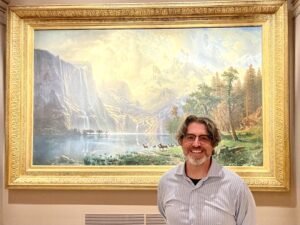
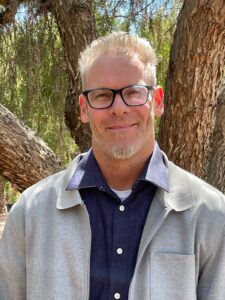
Q: When you were originally thinking about this exhibit, which spans a century of Bay Area environmental activism, what topics, themes, or events were important for you to include?
TH: As historians, both Roger and I approached the exhibit through the lens of change over time, essentially asking the question, “How did what we’ve come to recognize as environmentalism evolve and change in the Bay Area over the twentieth century?” Combining our knowledge of both the oral history collection – which was to stand at the heart of the exhibit – and the environmental history of California, we selected the three stories we wanted to highlight fairly quickly.
First, we wanted to tell the story of Hetch Hetchy, the valley in Yosemite National Park that was dammed for San Francisco’s water system. This is a seminal event used in history classes across the nation to highlight the battle between two schools of environmentalism, preservationists like the Sierra Club’s John Muir, and conservationists like Gifford Pinchot of the U.S. Forest Service in the first part of the twentieth century. For the exhibit, we sought to use the Hetch Hetchy story to introduce visitors to preservation as the first form of environmentalism that took root in the Bay Area.
Second, we wanted to tell the story of Save The Bay, the movement initiated by three women from Berkeley to halt bay fill. Ultimately, that movement led to the creation of the San Francisco Bay Conservation and Development Commission (BCDC), a state government agency to regulate development on the bay. Here we wanted to highlight how environmental concerns became embedded within the fold of government by the mid-century. BCDC stands as the first environmental agency in the United States, providing a precedent for other regulatory agencies on the state and federal level in the years that followed, such as the California Coastal Commission. Moreover, BCDC also operated within a framework that sought to balance environmental protection with economic development.
Third, we wanted to tell the story of environmental justice, a movement in the last part of the twentieth century that sought to put the health of people – particularly communities of color – within the environmental agenda. While environmental justice is fairly common today in discussions of environmental policy, the story of how it developed is not well known, and the Bay Area was one of the central places in the nation from which the movement took root.
REP: Todd and I worked to ensure that, in this exhibit, environmental activists could speak for themselves, and that visitors to the exhibit could actually hear the voices of activists recorded in their oral history interviews. The Audio Spotlight technology that allow people to hear interview clips in the gallery, the three videos Todd created with rare film footage and photographs, and the three podcast episodes we made with Sasha Khokha of KQED all make this exhibit something special that has never been done before in The Bancroft Library Gallery. For me, the people-power of communities of color demanding environmental justice, and the longtime leadership of women working for environmental protection were really important themes to include. Often, environmental history is told through the actions of men like John Muir, who does deserve credit for his early advocacy to protect nature through its preservation. The legacy of Muir and the ongoing work of the Sierra Club are important, and they remain so today. But Todd and I wanted to tell a deeper and broader history of Bay Area environmentalism, which shows how women and people of color have been central to the expansion and the evolution of environmental action over the course of the 20th century. I hope the stories shared in this exhibit help contextualize and make current environmental issues more meaningful—be it present-day preservation issues in 30 x ’30 campaigns, or conflicts over coastal regulations amid sea-level rise, or ongoing challenges to empower people of color in mainstream environmental movements.
Q: Did the themes you wanted to highlight change during the course of your research?
REP: We worked hard for over a year to bring this exhibit to life and to my memory, we agreed fairly early on about the three main narratives featured in the exhibit—the preservation of nature, reconciling environment and development, and environmental justice for communities of color. Over the course of our research, we changed the details of which particular oral history segment we might include here or there, or which image or document would best compliment the oral histories featured in each section of the exhibit. But as I recall, the exhibit’s main story arc remained steady from early in our curation process.
TH: Surprisingly, there was no change in the main topics / stories we wanted to highlight in the three sections of the exhibit. What our research did do was help expand on the themes within each to add more depth and nuance around community activism. For instance, in the first section we not only focused on the story of Hetch Hetchy, but connected it to activism around Save the Redwoods, which in turn highlighted the vital – yet often overlooked – role of women in the early preservation movement. Men like John Muir may have become the figureheads of environmentalism, and voted for such policies in government, but it was women who provided the grassroots momentum that put environmental concerns on the table. The same could be said for the third section on environmental justice. Our research uncovered a lot of different groups and experiences in the Bay Area grappling with environmental racism, from toxic sites in Richmond and what became known as the Silicon Valley, to debates with white environmental groups about even using the term “racism.” So in all, our research gave us a number of themes to spotlight and weave together throughout the exhibit
Q: The exhibit begins with the 1906 earthquake. Why did you decide to start there?
TH: This is another example of how research expanded the themes and stories of the three main topics we sought to feature in the exhibit. We wanted to highlight the story of Hetch Hetchy in the first section. Our research of the Hetch Hetchy battle forced us to upstream to the root cause – the 1906 earthquake and fire that destroyed 80 percent of San Francisco. At the time, San Francisco stood as the largest and richest city west of Chicago. In the wake of the disaster, the rebuilding effort posed a tremendous threat to the natural resources of the state. Ancient redwood forests throughout the Bay Area and along California’s north and central coast were targeted for timber, just as the Hetch Hetchy Valley was eyed for water and hydro-electric power. Thus, these rebuilding efforts proved the impetus of the early activism to preserve California’s environment.
REP: The drowning of Hetch Hetchy Valley—despite it being located within Yosemite National Park—is such a powerful and classic story in environmental history, and it occurred because the 1906 earthquake and fire destroyed San Francisco. Amazingly, Todd found several oral histories in our collection with survivors of the earthquake and fire who recall their experiences of it when they were children. In The Bancroft Library, Todd also found historic film footage, recently digitized, that shows San Francisco still aflame just after the earthquake. Putting those oral histories together with this footage make for a captivating start to the exhibit.
But what I didn’t realize until working on the exhibit was how the preservation of redwoods was also connected to how the earthquake and fire destroyed San Francisco. After the fire, lumber companies promoted California’s fire-resistant coastal redwoods as a means to rebuild the devastated city. In turn, environmentalists redoubled their efforts to preserve special groves of those ancient redwood trees. It suddenly made sense to me how Muir Woods National Monument was established in Marin County just a few years after the 1906 earthquake. Additionally, we wanted our exhibit on Bay Area environmentalism to highlight the Sierra Club, which was founded in San Francisco in 1892 and has since become one of the most influential environmental organizations in the nation. The Oral History Center has conducted oral histories with Sierra Club leaders since the early 1970s, and several activists, like William Colby, Ansel Adams, and David Brower, discussed in their oral histories how the fate of Hetch Hetchy continues to inform ongoing preservation efforts. So, in many ways, the 1906 San Francisco earthquake and fire helped ignite the spirit of preservation that still informs environmental activism, both in the Bay Area and across much of North America.
Q: What role does oral history play in the exhibit?
REP: Oral history is the beating heart that gives life to this exhibit! We scoured several scores of Oral History Center transcripts for captivating stories about Bay Area environmental activism. David Dunham helped us obtain digitized versions of those oral history recordings. We then used The Bancroft’s traditional paper, photograph, and film collections to complement the oral history narratives that we featured in the exhibit. Christine Hult-Lewis and Lorna Kirwan helped us explore several of those archival collections, and Theresa Salazar pointed us to the excellent Urban Habitat Program Records, 1970-2001, which are displayed in our exhibit. Ultimately, the exhibit offers a multi-sensory experience where visitors can engage audio recordings, film footage, oil paintings, photographs, pamphlets, posters, descriptive text, and they can even hold the hardbound oral history transcripts featured in the exhibit. But certainly, oral history is the centerpiece of the exhibit.
TH: In short, everything! This is the first exhibit curated by the Oral History Center, and the first in-depth effort to showcase both the oral history and other archival collections of The Bancroft Library. Each section features oral histories about the main topic in three ways. Edited oral history segments are played in each section through an Audio Spotlight speaker, and accompanied with a video that shows captions as well as related photographs and archival footage. The oral histories are also available through a three-episode podcast, narrated by Sasha Khokha from KQED San Francisco. The podcast episodes, available online and in the gallery by scanning a QR Code, offer a deeper dive into the stories of each section. Lastly, we used oral histories quotes in the labels of the exhibit material to add further detail and context.
Q: The 1960s and ’70s were two very productive decades in terms of environmental activism. Did the oral histories that you encountered from the OHC’s collection make you think differently about this period, or illuminate something new?
TH: In my view, the oral histories we used in the exhibit helped place the activism of the 1960s and 1970s in better context. For instance, we often think of the “environmental movement” as arising around the late 1960s / early 1970s. Yet, this view completely overlooks the activism of men and women around preservation in the first couple decades of the twentieth century. It also overlooks the vital work of Sierra Club executive director David Brower, whose activism throughout the 1950s and 1960s staved off numerous developments and led to the establishment of ten new national parks. In many respects, I think the oral histories featured in this exhibit pushed me to think about a “long environmental movement” that gained traction in the halls of government during the 1960s and 1970s. I think the exhibit also highlights how the Civil Rights Movement and environmental movement came to intertwine by the end of the decade to form environmental justice, which was an area I felt fortunate to learn more about through this project.
REP: Actually, rather than the 1960s and 1970s, the oral histories we included in the exhibit helped me realize the importance of the 1980s and 90s to the expansion and evolution of environmentalism. Without a doubt, activity surrounding Earth Day in 1970 was a key inflection point in environmental history, inspiring new environmental laws and a new generation of environmental activists. But the oral histories in our exhibit tell how Bay Area activists laid the early groundwork at least since the early 20th century for later environmental regulations, and how activists in the final decades of the 20th century worked to include all people in environmental protections, especially communities of color who suffered the most from industrial pollution.
Q: You put together additional material, like a podcast and class workbook, to accompany the exhibit. How do you hope people will use these materials?
TH: For the past couple years, the Oral History Center has been working on ways to get our collection into the K-12 education space. We developed additional materials, such as the class workbook and podcast, to serve as educational resources for K-12 classrooms, as well as undergraduate courses.
REP: The podcasts and educational workbook can be used anywhere—while visiting and experiencing the exhibit in person, or at home or in classrooms. We hope people use those additional materials long after the exhibit closes in November 2024!
Q: What do you hope that people take away from the exhibit?
REP: I hope exhibit visitors sense the importance, power, and potential of oral history. I hope they see how the Oral History Center’s work to record the lived experiences and reflections of people through oral history creates invaluable records that helps us better understand where we’ve come from and helps us make sense of our experiences today. I also hope visitors realize the importance of Bay Area activists in shaping the evolution of environmentalism over time. And I hope visitors hear how the actions of Bay Area people in the past, as told in their own words, helped define our experiences in the Bay Area today. Given today’s grave threats to our environment and to our democracy, I hope visitors appreciate how environmental activism remains an ongoing process that is shaped and renewed by average people like them who engage in civic activism. I also hope the oral histories featured in this exhibit—and the many, many more that are preserved in the Oral History Center collection—help inspire people to shape and renew environmentalism today and in the future.
TH: I hope visitors come away from the exhibit with a better understanding of how environmentalism evolved and changed over the century, and that it has a long history in the Bay Area. Moreover, I hope the oral histories featured in the exhibit highlight the change brought on by everyday people. It was the activism of men and women that led to protected redwood forests and the creation of state and national parks. It was the unwavering dedication of three women from Berkeley that stopped fill projects in San Francisco Bay and led to the nation’s first government-run environmental agency. And it was the collective action of communities of color that put justice within the environmental agenda, and on the dockets of policymakers. Ultimately, I hope visitors, young and old, walk away with the idea that change comes about through everyday people.

“Voices for the Environment: A Century of Bay Area Activism,” an Oral History Center exhibit in The Bancroft Library Gallery
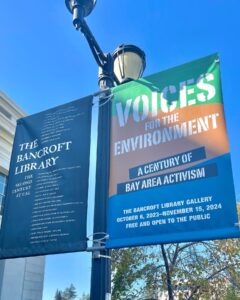
We’re excited to announce the opening of Voices for the Environment: A Century of Bay Area Activism, a Bancroft Library Gallery exhibition that was curated by Todd Holmes, Roger Eardley-Pryor, and Paul Burnett of the Oral History Center. Voices for the Environment traces the evolution of environmentalism in the San Francisco Bay Area across the twentieth century. In three sections, it highlights how Bay Area activists have long been on the front lines of environmental change—from efforts to preserve natural spaces in the wake of the 1906 San Francisco earthquake and fire, to the midcentury fight for state regulations to protect San Francisco Bay shoreline, to more recent demands for environmental justice to address the disproportionate burden of pollution that sickened communities of color around the Bay.
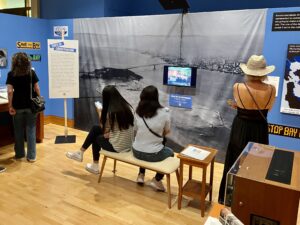
Our Voices for the Environment exhibit is the first major effort in The Bancroft Library Gallery to showcase oral history alongside the traditional archival collections of The Bancroft Library, with the oral history collections leading the way. The exhibit still features historic photographs, pamphlets, post cards, and posters selected from several collections of The Bancroft’s physical archives. But for the first time in this gallery, our Voices for the Environment exhibit also includes three installations of special Audio Spotlight technology where you can listen to never-before-heard oral history recordings with Bay Area environmentalists, while simultaneously watching three videos edited by Todd Holmes that feature historic photographs and rare film footage from The Bancroft’s digital collections. Additionally, as a complement to the exhibit, curators Todd Holmes and Roger Eardley-Pryor created an educational workbook, so students of all ages can learn about the environmental movement by engaging with the themes and primary sources on display. Through these efforts, the Oral History Center hopes Voices for the Environment will have a life beyond its yearlong run.
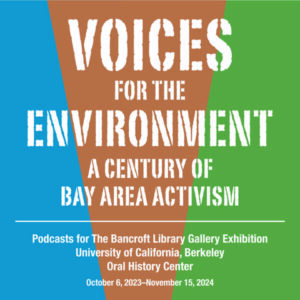
For an even deeper dive, you can also scan a QR code in the gallery, or click the following link, to hear three Voices for the Environment podcast episodes produced in partnership with Sasha Khokha of KQED Public Radio and The California Report Magazine. The podcast episode for section 1 of the exhibit, titled “A Preservationist Spirit,” traces the environmental activism that arose amid the rebuilding efforts of San Francisco after the 1906 earthquake and fire, efforts that came to target the state’s ancient redwood forests and the beloved Hetch Hetchy Valley in Yosemite National Park. The episode features historic interviews from the Oral History Center archives including segments from the “Growing Up in the Cities” collection recorded in the late 1970s by Frederick M. Wirt, as well as oral history interviews with Carolyn Merchant recorded in 2022, with Ansel Adams recorded in the mid-1970s, and with David Brower recorded in the mid-1970s. The oral history of William E. Colby from 1953 was voiced by Anders Hauge, and the oral history of Francis Farquhar from 1958 was voiced by Ross Bradford. This first episode also features audio from the film Two Yosemites, directed and narrated by David Brower in 1955. The podcast episode for section 2 of the exhibit, titled “Tides of Conservation,” tells the story of the Save San Francisco Bay movement and the creation of the San Francisco Bay Conservation and Development Commission (BCDC), one the nation’s first environmental regulatory agencies. The episode features segments from oral history interviews with Save The Bay founders Esther Gulick, Catherine “Kay” Kerr, and Sylvia McLaughlin recorded in 1985; as well as interviews with BCDC executive director Joseph Bodovitz and chairman Melvin B. Lane, both recorded in 1984. And the podcast episode for section 3 of the exhibit, titled “Environmental Justice for All,” spotlights efforts by communities of color to place the health of people within the environmental agenda, including creation of new environmental organizations like the West County Toxics Coalition, the Urban Habitat Program, and APEN (Asian Pacific Environmental Network), all founded in the Bay Area. The episode features segments from oral history interviews with Carl Anthony, Pamela Tau Lee, Henry Clark, and Ahmadia Thomas, all recorded in 1999 and 2000.
The Voices for the Environment exhibition space was designed by Gordon Chun and is free and open to the public Monday through Friday between 10am to 4pm from Oct. 6, 2023 to Nov. 15, 2024, in The Bancroft Library Gallery, located just inside the east entrance of The Bancroft Library.
We hope you come to campus and experience it!
ABOUT THE ORAL HISTORY CENTER
The Oral History Center of The Bancroft Library preserves voices of people from all walks of life, with varying political perspectives, national origins, and ethnic backgrounds. We are committed to open access and our oral histories and interpretive materials are available online at no cost to scholars and the public. You can find our oral histories from the search feature on our home page. Search by name, keyword, and several other criteria. Sign up for our monthly newsletter featuring think pieces, new releases, podcasts, Q&As, and everything oral history. Access the most recent articles from our home page or go straight to our blog home.
Please consider making a tax-deductible donation to the Oral History Center if you’d like to see more work like this conducted and made freely available online. While we receive modest institutional support, we are a predominantly self-funded research unit of The Bancroft Library. We must raise the funds to cover the cost of all the work we do, including each oral history. You can give online, or contact us at ohc@berkeley.edu for more information about our funding needs for present and future projects.
Exhibit: Letters | الحروف How Artists Reimagined Language in the Age of Decolonization
Letters | الحروف How Artists Reimagined Language in the Age of Decolonization
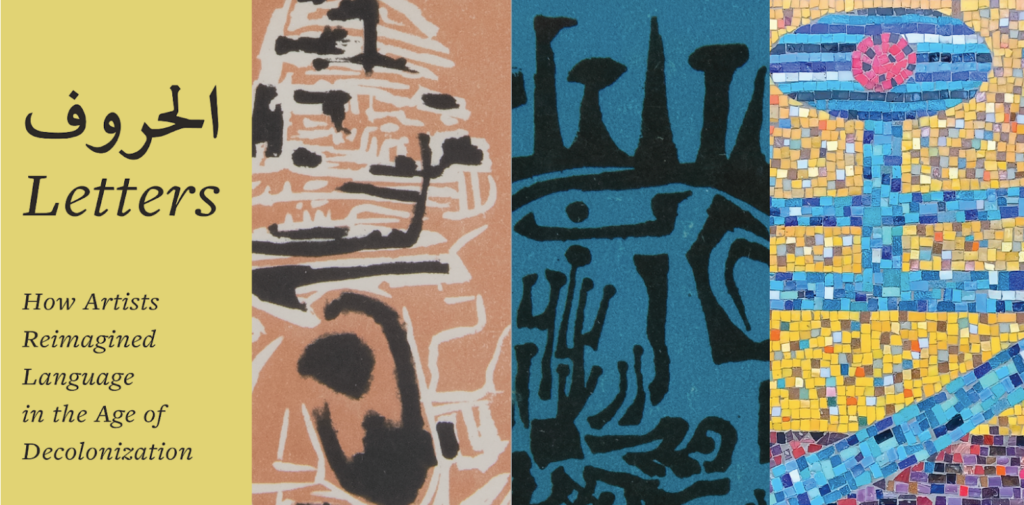
Left to right: art by Mohammed Khadda, Ibrahim El-Salahi, and Bedri Rahmi Eyüboğlu (details)
Letters | الحروف How Artists Reimagined Language in the Age of Decolonization is on exhibit in Doe Library’s Bernice Layne Brown Gallery from March 13 until Aug. 31, 2023. How have modern artists in North Africa, the Middle East, and South Asia made use of their inheritance of a visual cache of Arabic signs and letter-forms, and with what meanings? This exhibition, curated by students in the seminar History of Art 192Cu, “Exhibiting Calligraphic Modernism,” in collaboration with the Library, explores work by dozens of artists in multiple media, from poster design to painting, mosaic, poetry, and animation. A shared backdrop to the artwork on display are the decolonization processes and liberation struggles taking place across Asia, Africa, and Latin America in the 1950s, 1960s, and 1970s, which sparked desires to create cultural futures in resistance to dominant imperial values and official language policies.
Exhibit Curators: Drew Atkins, Riana Azevedo, Lynn Cunningham, Sharan Dulai, Eva Elfishawy, Mohamed Hamed, Teddi Haynes, Murtaza Hiraj, Viv Kammerer, Shanti Knutzen, Marissa Lee, Anneka Lenssen, Val Machado, Jasmine Nadal-Chung, Reyansh Sathishkumar, A. Wara, Alice Xie, Jinyu Xu, Suri Zheng, and Hayley Zupancic
Exhibit dates: March 13 to Aug. 31, 2023
Location: Bernice Layne Brown Gallery, Doe Library
Opening reception
Wednesday, March 15, 2023, 5-6:30 p.m.
Morrison Library
The reception will feature brief remarks by members of the curatorial team. Tours of the exhibition will be led by student-curators beginning at 5:45 p.m. Food and drinks will be served.
A pre-reception event will take place from 2:30-4:30 p.m. in 308A Doe Library, and will include a presentation and Arabic calligraphy workshop by the Bay Area-based calligrapher Zubair Simab. Participants will have an opportunity to try writing Arabic letters with a prepared pen and ink. There are 40 slots available for the workshop. Please register here: http://ucblib.link/calligraphyRSVP.
Both of these events are open to the public.
Details:
Wednesday, March 15, 2023
Pre-reception calligraphy workshop
2:30-4:30 p.m.
308A Doe Library
Register: http://ucblib.link/calligraphyRSVP
Exhibit reception and tours
5-6:30 p.m.
Morrison Library (101 Doe Library)
If you require an accommodation to fully participate in this event, please contact Amber Lawrence at libraryevents@berkeley.edu or 510-459-9108 at least 7-10 days in advance of the program.
Sponsors/contributors: Center for Middle East Studies, Department of History of Art, and UC Berkeley Library
South/Southeast Asia Library 50th Anniversary Exhibit Launch
The Bernice Layne Brown Gallery on the first floor of Doe Library is now housing the exhibit “Celebrating 50 Years of Excellence: South & Southeast Asia Scholarship and Stewardship at Berkeley, 1970-2020.”
This exhibit celebrates the academic achievements of Berkeley South and Southeast Asia scholars across disciplines. It recognizes Berkeley’s robust South and Southeast Asian language instruction program, distinguished teaching award recipients, and previous Charlene Conrad Liebau Library Prize for Undergraduate Research winners and honorable mentions.
The South/Southeast Asia Library plays a pivotal role in building interdisciplinary collections in all major formats and languages and has, for five decades, served as the scholarly lifeline for vibrant South and Southeast Asian Studies communities, both local and global.
This exhibit uses a variety of faculty publications and special collections to highlight Berkeley scholarship’s evolution, scope, and profound impact. Source collections and libraries whose noteworthy treasures are most featured in the exhibit include The Bancroft Library, Doe Library, Music Library, and the South/Southeast Asia Library.
The exhibit will be on display until the end of October 2021.
Exhibit: Whose University? The 50th Anniversary of the UC Berkeley Third World Liberation Front Strike
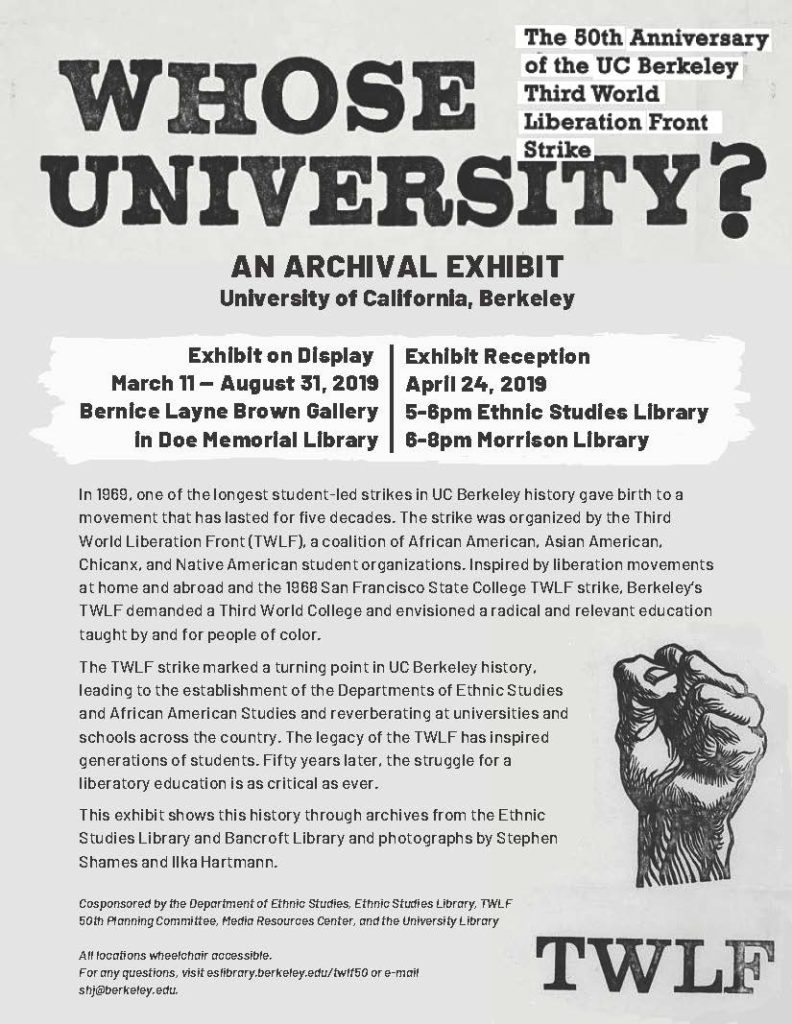
Exhibit: Love across the Global South
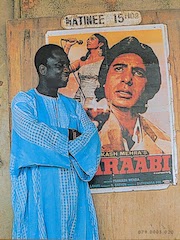
Love across the Global South: Popular Cinema Cultures of India and Senegal explores interconnections between South Asian and African popular cultures through film posters, footage, and memorabilia. Focusing on the circulation of Bombay cinema, South Asia’s largest film industry, in Senegal, West Africa, the exhibition foregrounds the role of transnational film cultures and fan clubs in shaping affinities across the Global South. Highlighting archival material held by UC Berkeley—including a collection of twentieth-century popular film magazines and films housed at the Media Resources Center—the exhibition harnesses library holdings to nuance campus debates on race, globalization, and visual representation while experimenting with new curatorial practices that emphasize Afro-Asian connections in an expanded Indian Ocean imaginary. The exhibition is curated by Sugata Ray (Assistant Professor, History of Art), Ivy Mills (Lecturer, History of Art), Liladhar Pendse (Librarian, Central Asian and Eastern European Studies), and Adnan Malik (Curator for South Asian Collections, South/Southeast Asia Library). The Mellon Curatorial Preparedness Initiative funded Curatorial Assistantships for History of Art Department graduate students Shivani Sud and Randip Bakshi.
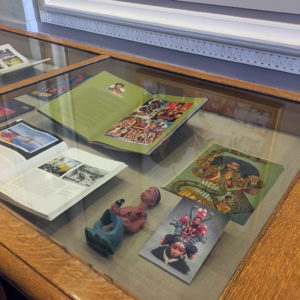
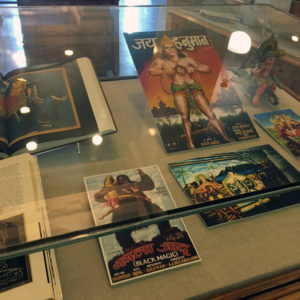
The exhibit runs from October 6, 2017–March 1, 2018 in the Bernice L. Brown Gallery, Doe Library.
Exhibit: Beyond Tintin and Superman: The Diversity of Global Comics
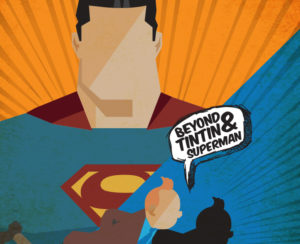 Join us on Friday, October 14, from 5-7pm in the Morrison Library to celebrate the opening of “Beyond Tintin and Superman: The Diversity of Global Comics.”
Join us on Friday, October 14, from 5-7pm in the Morrison Library to celebrate the opening of “Beyond Tintin and Superman: The Diversity of Global Comics.”
Curated by Liladhar Pendse, the exhibit features comics and graphic novels from a dizzying array of cultures, including Egypt, Poland, South Africa, Israel, the Czech Republic, Colombia, and Japan. The materials can be viewed in Doe Library’s Bernice Layne Brown Gallery through March 2017.
The event will feature talks by Ron Turner, founder of the Last Gasp, a book and underground comics publisher and distributor based in San Francisco, and UC Berkeley Art History Lecturer Ivy Mills, Ph.D., who specializes in the visual and literary cultures of Africa and the African diaspora.
To learn more about the exhibit and watch a video on the materials, read our story here.
Exhibit: The Gift to Sing: Highlights of the Leon F. Litwack & Bancroft Library African American Collections
I’m sharing this announcement of Bancroft’s new exhibit:
The Bancroft Library just opened its fall/winter exhibition, The Gift to Sing: Highlights of the Leon F. Litwack & Bancroft Library African American Collections. Leon Litwack is a historian and legendary professor who taught here from 1964 to 2007. He won the Pulitzer Prize for History and the National Book Award for his 1979 book Been In the Storm So Long: The Aftermath of Slavery. He has been collecting books relating to African American history and culture since the 1940s and his collection is now perhaps the best in private hands. Ultimately, it will be coming to The Bancroft Library but highlights, along with related material from Bancroft’s collection, will be on display until February.
Highlights from Professor Litwack’s collection include Bobby Seale’s copy of The Autobiography of Malcolm X, a copy of Narrative of the Life of Frederick Douglass, an American Slave inscribed by William Lloyd Garrison and Ida B. Wells’ incredibly rare and important pamphlet on lynching, The Red Record.
Bancroft highlights include the first printing of Phillis Wheatley’s collection of poems from 1773 and early works printed in California.
The Bancroft Library Gallery is open from Monday to Friday, 10-4.
http://www.lib.berkeley.edu/libraries/bancroft-library/current-exhibits
David Faulds
Curator of Rare Books and Literary Manuscripts
Exhibit: No Legacy || Literatura Electrónica
No Legacy || Literatura Electrónica
Exhibit – Multimedia | March 11– September 2, 2016 | Doe Library, Bernice Layne Brown Gallery
OPENING SYMPOSIUM – A Round Table Discussion
Friday, March 11 from 10am to 12:30pm, BIDS (Doe 190)
OPENING RECEPTION with poet Amaranth Borsuk and writer Doménico Chiappe
This exhibition, NL||LE, presents a collection of digital works of literature—in Spanish, Portuguese, Catalan as well as English—side by side with experimental print materials from the past century. Meant to be read on computers and other digital devices, the electronic stories and poems reveal new ideas about literary and media developments and encourage visitors to interact with the machines. Exhibit cases and tables were designed by students in a Berkeley Center for New Media seminar. Through the use of vintage computing equipment, NL||LE also highlights challenges involved in the preservation of electronic literature.
With additional support from the Hellman Foundation, Townsend Center for the Humanities, College of Letters and Science, Digital Humanities at Berkeley, Institute of European Studies, Portuguese Studies Program, Fundação Lusoamericana, Center for Latin American Studies, Berkeley Institute for Data Science, and the Institute for Digital Research in the Humanities, University of Kansas.
All events are free and open to the public.
